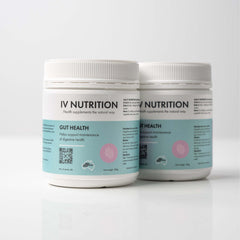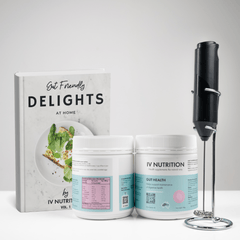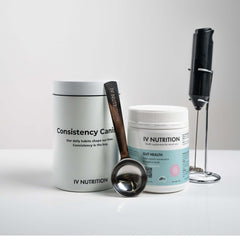The Mystery of the Expanding Waistband
Ever finish a perfectly decent meal, only to feel like you’ve been inflated like a party balloon? Bloating is one of the most frustrating digestive issues people face — and it’s not just in your head. According to research, up to 30% of people experience bloating on a regular basis【source: https://www.ncbi.nlm.nih.gov/pmc/articles/PMC6110269/】.
But here’s the kicker: while several foods are known culprits, one food consistently rises to the top of the bloating blacklist.
So, what is the number one food that causes bloating?
Let’s dig into the science (with a few laughs along the way), explore why your belly rebels, and introduce you to a secret weapon that your gut’s going to love: a special kind of prebiotic fibre.
Drumroll, Please… The #1 Food That Causes Bloating Is: Beans
Yes, beans. Legumes. Those tiny nutritional powerhouses that boast protein, fibre, and a chorus of health benefits… and also the capacity to make your digestive tract perform a symphony of gurgles, cramps, and gas.
While beans may not be the only food that causes bloating, they top the list due to their specific composition — particularly oligosaccharides, a type of carbohydrate that resists digestion until it reaches your colon.
Once in the colon, these carbs become a microbial buffet. Your gut bacteria feast and ferment, releasing gases like hydrogen, methane, and carbon dioxide — which can lead to the all-too-familiar bloated belly.
Let’s Break Down Why Beans Cause Bloating
1. Rich in FODMAPs
Beans are loaded with FODMAPs (Fermentable Oligosaccharides, Disaccharides, Monosaccharides, And Polyols) — short-chain carbs that are poorly absorbed in the small intestine【source: https://www.monashfodmap.com/】. When they hit the colon, they’re fermented by bacteria, causing gas, water retention, and discomfort.
2. Resistant Starch & Fiber
Beans also contain a type of starch that escapes digestion in the small intestine. This “resistant starch” contributes to fermentation in the large intestine, triggering further gas production.
3. Your Microbiome Matters
Not everyone gets bloated from beans. People with diverse and balanced gut bacteria tend to tolerate them better. If your gut microbiome is a bit out of whack (what researchers call “dysbiosis”), you’re more likely to suffer digestive side effects.
Other Honorable Mentions: Foods That Frequently Cause Bloating
Before we demonize beans completely, it’s worth noting that bloating is personal. Here are other common culprits:
-
Dairy products (if lactose intolerant)
-
Carbonated beverages
-
Cruciferous veggies like broccoli and cabbage
-
Artificial sweeteners (sorbitol, mannitol, xylitol)
-
Wheat (especially in those with gluten sensitivity)
-
Onions and garlic (high in fructans, another FODMAP group)
Your mileage may vary, but beans tend to hit the hardest, especially if your gut is already stressed.
So, Should You Ban Beans Forever?
Absolutely not.
Beans are nutritional dynamos, packed with protein, minerals, and heart-healthy fibre. Cutting them out permanently robs you of serious benefits. The better path? Train your gut to tolerate them.
Here’s how:
-
Start slow: Introduce small portions of cooked lentils or mung beans first.
-
Soak & rinse: Reduces oligosaccharide content significantly.
-
Use digestive aids: Try enzymes like alpha-galactosidase (e.g., Beano) to break down difficult sugars.
-
Support your gut with prebiotics (stay tuned — we’ll cover this in a minute).
When Bloating Becomes More Than a Nuisance
Occasional bloating is common. But chronic bloating that interferes with daily life could signal something deeper:
-
Irritable Bowel Syndrome (IBS)
-
Small Intestinal Bacterial Overgrowth (SIBO)
-
Food intolerances
-
Gastroparesis
-
Celiac disease
If your bloating is severe, persistent, or painful, consult a gastroenterologist. Don’t just blame the beans.
The Gut-Bloating Balancing Act: It’s All About the Microbiome
The health of your gut microbiome — the trillions of bacteria living in your digestive tract — determines how well you tolerate foods, how well you digest fibre, and how prone you are to bloating.
When your microbiome is imbalanced:
-
You’re more likely to have excess gas production.
-
Your motility slows down.
-
Inflammation increases.
In contrast, a well-fed, diverse microbiome can help you break down tough foods like beans, regulate digestion, and reduce bloating.
Enter: Prebiotic Fibre (Your Bloating Antidote)
You’ve heard of probiotics — the live “good” bacteria in yogurts and supplements. But what about prebiotics?
Prebiotics Are Gut Food
Prebiotics are special fibres that feed your beneficial gut microbes. When you fuel these bacteria, they produce short-chain fatty acids like butyrate, which help:
-
Strengthen your gut lining
-
Reduce inflammation
-
Improve motility
-
Lower gas-producing fermentation
Prebiotics Can Reduce Bloating Over Time
While some fibres can worsen bloating (especially insoluble ones), gentle, fermentable prebiotics actually help regulate your gut in the long run.
Over time, feeding your beneficial bacteria the right fuel reduces dysbiosis, balances fermentation patterns, and improves overall digestion — making you more resilient to gas-producing foods like beans.
Spotlight on IV Nutrition’s Virgin Sugarcane Prebiotic Fibre
Let’s talk about a standout in the prebiotic world: IV Nutrition’s Virgin Manufactured Sugarcane Prebiotic Fibre.
This isn’t just hype. It’s a next-generation prebiotic derived from sugarcane and manufactured to preserve purity, potency, and gut-friendliness.
Why It Works:
-
Supports good bacteria without feeding harmful gas-producers.
-
Gently fermented – minimal bloating, cramping, or discomfort.
-
Sustainably sourced and clinically formulated for real results.
Thousands of IV Nutrition users report smoother digestion, less bloating, and regular bathroom visits (blessed be the bowel gods).
The Best Part? It’s FREE to Start.
Yep. Your first tub is 100% free when you subscribe. No gimmicks. No fine print. Just a powerful gut reset — naturally.
👉 Click here to claim your FREE tub and see why prebiotic fibre might just be the missing link in your bloating battle.
Real Results: How to Use It
-
Mix one scoop into water, smoothies, or yogurt.
-
Start slow — half a scoop if you're new to fibre.
-
Use daily for 2–4 weeks to see maximum benefits.
Over time, your microbiome adapts, inflammation drops, and digestion normalizes. It's not a miracle — it’s microbial nutrition.
Additional Strategies to Beat Bloating
1. Movement Is Medicine
Walking after meals speeds up digestion and reduces gas retention. Even light stretching helps — think yoga poses like “Wind-Relieving Pose” (yes, it’s really called that).
2. Eat Mindfully
Chewing thoroughly, avoiding air swallowing, and eating slowly can significantly reduce bloating.
3. Drink More Water
Hydration helps fiber do its job. Aim for 2+ liters a day, especially if you’re increasing prebiotic intake.
4. Limit Artificial Sweeteners
Sugar alcohols like sorbitol and xylitol are notorious gas-producers. Check your gum, protein bars, and drinks.
FAQs About Bloating and Beans
Q: Are beans bad for everyone?
Nope. In fact, cultures with the highest legume intake often have the best gut health. It's all about gut adaptation and supporting digestion.
Q: Can I just take probiotics instead of prebiotics?
You can, but they won’t be as effective long-term without the fuel they need to thrive. Think of prebiotics as fertilizer and probiotics as seeds — both are crucial.
Q: How long does it take for prebiotic fibre to reduce bloating?
Some people feel improvement in 3–5 days, others in 2–3 weeks. The key is consistency.
Final Thoughts: Don't Fear the Bean — Fix the Gut
Bloating is your body’s way of waving a little red flag. While beans top the list of bloating offenders, the real story lies deeper — in how your body processes what you eat, and how your gut microbiome responds.
You don’t have to cut out nutritious foods like legumes forever. Instead, focus on:
-
Balancing your microbiome
-
Supporting digestion with prebiotic fibre
-
Identifying personal food triggers
-
Nourishing your gut with the love (and science) it deserves
Because let’s face it: feeling good in your body shouldn’t be a guessing game — and you deserve to eat a burrito without fearing the bloat.
Your Gut-First Game Plan
✅ Start with a gentle prebiotic fibre — IV Nutrition’s Virgin Sugarcane Fibre is free to try
✅ Ease back into beans — soak, cook, and chew well.
✅ Listen to your belly — and your bacteria.
✅ Give your gut the tools to thrive — not just survive.
Because bloating is optional — and feeling amazing? That should be standard.





